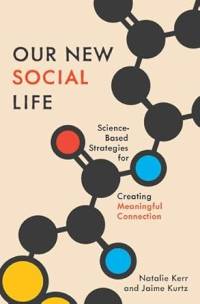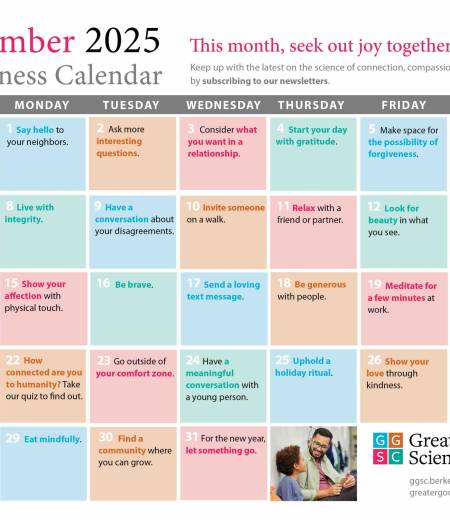If you search Google for ways to find social connection, you might come across advice like “reach out to existing acquaintances,” “join a club,” or “get involved in your community.” This commonsense advice implies that forming connections is as simple as putting yourself out there.

While reaching out is certainly important, it’s often not enough on its own. The truth is that we routinely encounter barriers that block our efforts to make and strengthen meaningful relationships. Some of these barriers are byproducts of our psychological makeup, while others are the result of unseen social forces. As a result, the path to connection is not always easy to navigate.
In our new book Our New Social Life: Science-Backed Strategies for Creating Meaningful Connection, we explore seven key barriers to social connection and offer evidence-based strategies for overcoming them. We believe that, by addressing these obstacles, connection can happen more easily.
So, what are these barriers? Here’s a sneak peek.
1. We view social connection as a luxury
As humans, we have a hardwired need for social connection—and we live happier, healthier, and longer lives when we’re closely connected to others. Yet, in today’s world, socializing is often seen as a luxury rather than a necessity, which is why many of us push it to the bottom of our priority lists. We squeeze it in only after work, family obligations, and chores are done. Perhaps it’s no surprise, then, that the average American spends just 34 minutes a day socializing.
The belief that social connection is a luxury can become a barrier to social connection, and it’s one that we might not even be aware of. To overcome this, we need to recognize that social connection is an essential health behavior—just as important as sleep, exercise, and good nutrition—and prioritize it accordingly. While the need for connection might be felt differently for each of us, depending on our personalities and preferences, we all need to invest time and energy into our relationships.
2. We’re influenced by social norms that breed disconnection
Social norms—the unwritten rules for normal or acceptable behavior in a given context—exert a subtle yet powerful influence over our lives. They shape everything from how we interact with strangers on a train to how quickly we respond to text messages. While we often feel compelled to follow these social norms, doing so can sometimes leave us feeling disconnected.
There are dozens—maybe hundreds—of social norms that can create a barrier to meaningful social connection. Consider a relatively new norm: using a smartphone in social settings. In a recent survey, nearly 90% of U.S. adults admitted to using their phone during their most recent social interaction. You can see this behavior at nearly any restaurant, wedding reception, or fraternity party. While it has become a norm, research finds that phone use can diminish our enjoyment of social interactions and undermine our sense of connection to friends and family.
Here are a few more examples of modern norms that can take a toll on our social lives:
- More of us are living and working alone.
- Our in-person social networks are shrinking.
- We move a lot.
- Parents devote so much time and energy to child-rearing that they don’t have much left for socializing.
If we want to cultivate a healthier, more fulfilling social life, we need to start questioning—and pushing back against—some of these norms.
3. Our thoughts distort our perception of the social world
When it comes to thinking about the social world, we have a few common biases and blind spots that prevent us from seeing things clearly. For example, most of us think we’re better than average in a number of domains (like driving ability), but we’re overly pessimistic about our social life. We inaccurately think that other people attend more parties, have more friends, and enjoy a larger social circle than we do ourselves. It’s a distorted perception that can lead to feelings of disconnection and dissatisfaction.
We also see the social world through the filter of our past experiences. For example, if we’ve faced rejection in the past or struggled with prolonged loneliness, we might begin to expect rejection from others. Research finds that these expectations can become self-fulfilling prophecies. When we anticipate rejection, we may unintentionally act cold or distant, which can prevent others from warming up to us.
While many factors distort our social perception, we can learn to recognize our biases, question our assumptions, and adopt a more positive outlook on the social world. When we expect good things, we increase the odds of them happening.
4. We have miscalibrated expectations of social interaction
Research finds that we have mistaken (or “miscalibrated”) expectations about reaching out to others. For one thing, we tend to underestimate how much we’ll enjoy talking to strangers. In one series of studies, researchers asked commuters on buses and trains in the Chicago metropolitan area to interact with a fellow passenger or sit in solitude. They found that those who made small talk during their commute were in better moods afterward than those who sat in solitude. This finding has been replicated in different settings and cities, and it holds for both extraverts and introverts.
Are you surprised? If so, you’re in good company. In the commuter studies, some people were asked to predict what would make them happier: talking to a stranger or spending time in solitude. The majority guessed that they’d be happier in solitude! That’s a classic social miscalibration.
We also tend to underestimate how much others will appreciate our efforts to connect with them. This keeps us from doing things like reaching out to old friends, expressing gratitude to those we’ve never properly thanked, offering social support to people in need, and performing acts of kindness. The gap between our expectations and reality can create a barrier to social connection, but the gap can be successfully bridged.
Start by believing that most people are open to a friendly moment of connection. Trust that your friends will appreciate your attention, gratitude, support, and kindness. Chances are, they truly will.
5. We overlook the simple factors that create connection
 This essay is adapted from Our New Social Life: Science-Backed Strategies for Creating Meaningful Connection (Oxford University Press, 2025, 192 pages).
This essay is adapted from Our New Social Life: Science-Backed Strategies for Creating Meaningful Connection (Oxford University Press, 2025, 192 pages).
Many people think that the process of making friends is mysterious or determined by a person’s unique attributes—like a great sense of humor or good looks, for example. While these factors do matter, research suggests that liking is also triggered by simple, mundane factors—like how often you cross paths with someone, or how much you have in common. Overlooking these simple factors can cause you to miss out on the opportunities for connection that are right in front of you.
One of the most overlooked factors is proximity—or being physically close to others. In the words of social psychologist Elliot Aronson, “the people who are geographically nearest to you are most likely to become dearest to you as well.”
There’s nothing mysterious about the power of proximity. The more you see someone, the more opportunities you have to smile at one another, say hello, strike up a conversation, and discover common interests. However, the power of proximity is also due to a very basic psychological phenomenon known as the mere exposure effect. In short, the more we’re exposed to something, the more we tend to like it, and this applies to foods, scents, songs on the radio, and—yes—people.
There’s an easy way to put the mere exposure effect to work for you: Just let yourself be seen. Turn on your camera during Zoom meetings, comment on your friends’ social media posts, or go to the yoga studio instead of streaming a class in your living room. And try to be seen repeatedly. You could try going to the gym at the same time each day or attending the 9:00 a.m. church service every Sunday. This increases the chances of crossing paths with the same people. Over time, you’ll start recognizing others, and they’ll begin to recognize you, which could lead to something more.
6. We’re reluctant to do what it takes to create deeper connection
Many of us crave deep, meaningful connection, but we often shy away from the behaviors that help foster this type of connection—things like having deep conversations, disclosing personal information, and showing vulnerability.
Consider one study in which participants engaged in both shallow and deep conversations with strangers. In the shallow conversation, participants answered questions such as: How is your day going so far? In the deep conversation, participants disclosed more personal information by answering questions like: If you could undo one mistake you have made in life, what would it be, and why would you undo it?
The results showed that participants expected to prefer the shallow conversation, but they actually preferred the deeper one. The participants also felt closer to their deep conversation partner than to their shallow conversation partner. This work suggests that when we play it safe, we might be missing out on opportunities for meaningful social connection.
7. We miss opportunities to create connection on demand
When we think about improving our social lives, we often focus on external changes (“I should move to a more progressive city”) or place the responsibility on others (“I’ll be happy once I find a partner”). However, research suggests that we don’t need to wait for our circumstances to change or rely on others to feel connected. We can create this feeling on demand by engaging in practices that enhance our inner sense of connection.
One powerful way to create connection on demand is by experiencing awe. Awe is the feeling of being in the presence of something vast and beyond your understanding—like the sense of wonder you might experience gazing up at the Milky Way. Research finds that experiencing awe can deepen our sense of connection to others and to humanity as a whole. As awe researchers explain, “awe shifts people away from being the center of their own individual worlds, toward a focus on the broader social context and their place within it.”
Nature is one of the most reliable sources of awe, but it’s not the only one. Awe can also be felt in moments like witnessing the birth of a child, listening to a beautiful piece of music, or even watching someone lend a helping hand to a stranger. These experiences remind us that we’re a small part of a larger whole—and they foster a sense of connection, even when we’re physically alone.
The road to connection may be filled with speed bumps, roadblocks, and detours, but there are many practical strategies for navigating them. By simply changing your mindset and developing some new habits, you can enrich your social life and experience deeper connections with others who share the journey.








Comments